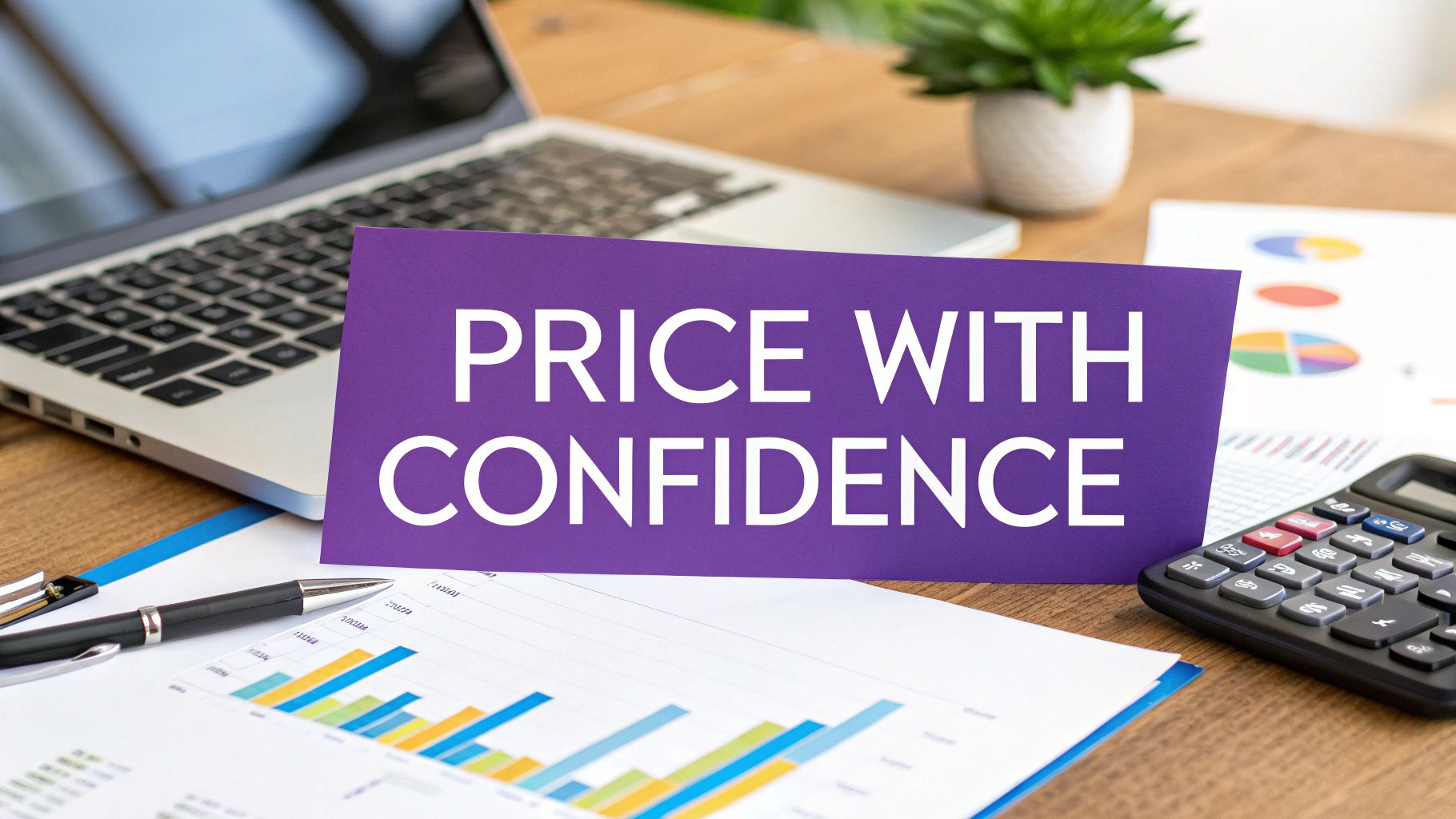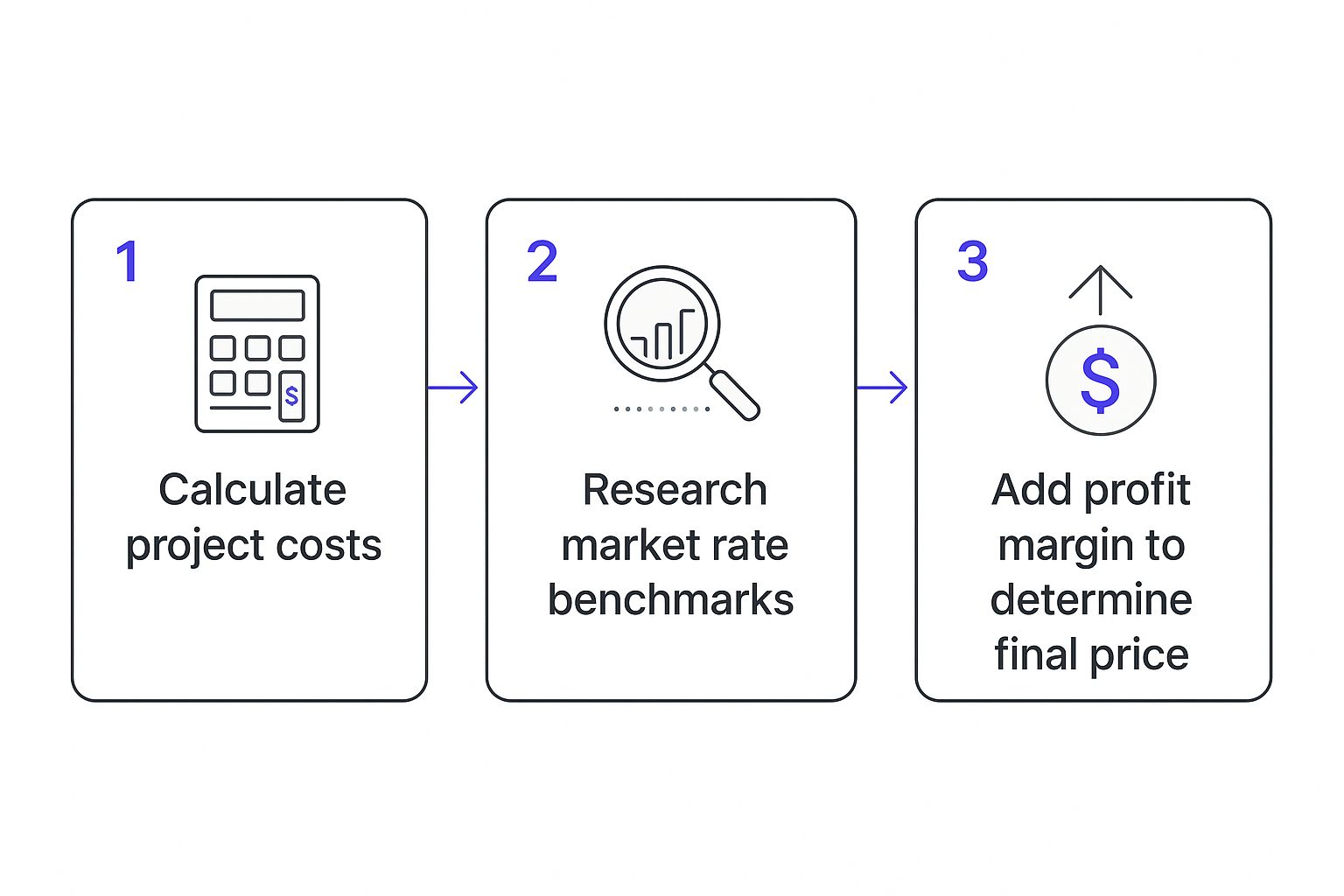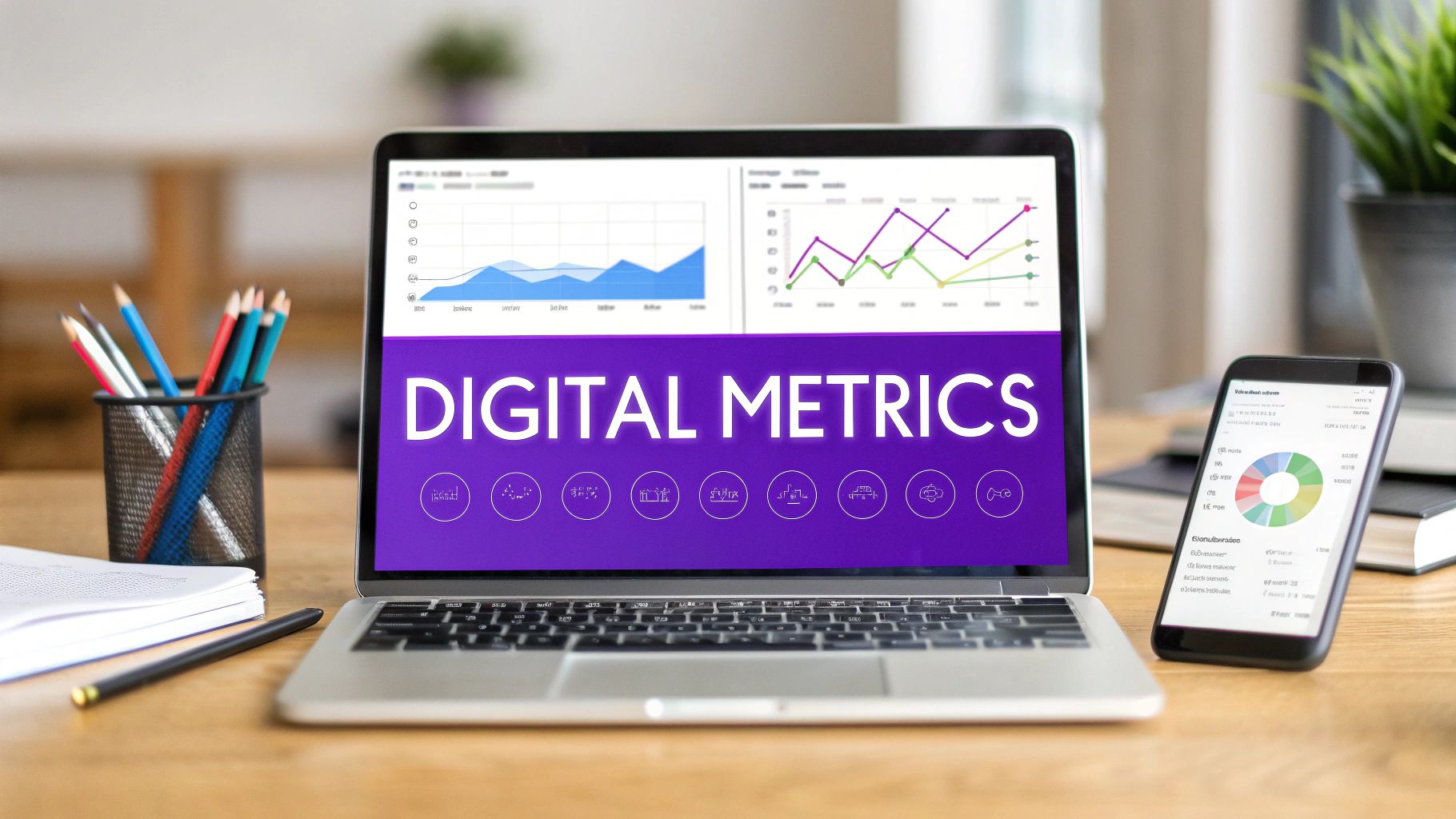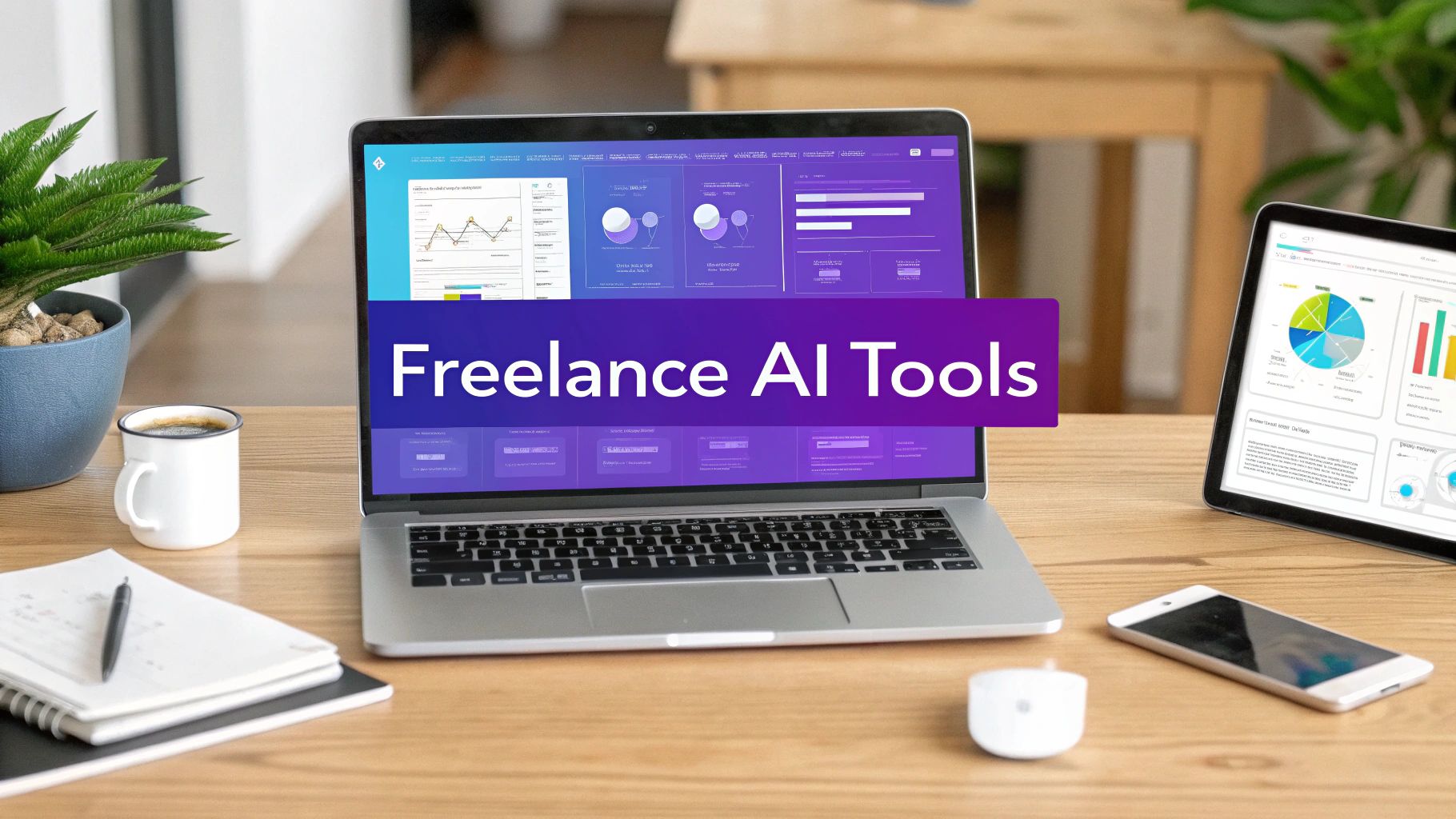How to Price Consulting Services with Confidence

Figuring out your consulting rates isn't just about picking a number out of thin air. It all starts with three core elements: defining the real value you bring to the table, sizing up your market, and knowing exactly who your ideal client is. Nailing this foundation means your rates will be tied to tangible results, not just the hours you put in. That’s how you start charging what you’re truly worth.
Build Your Foundational Pricing Strategy

Before you even think about a calculator, you need to get crystal clear on what you’re selling. Pricing isn’t just a number on an invoice; it's a powerful statement about your brand, your expertise, and the outcomes you guarantee.
Too many consultants make the classic mistake of pegging their price to their time. But let's be honest—clients don't buy your hours. They buy results.
The mental shift is simple but profound. Stop asking, "What is my time worth?" and start asking, "What is this outcome worth to my client?" Answering that question is the bedrock of a confident and profitable pricing strategy.
Define Your Unique Value Proposition
Your value proposition is so much more than a list of skills or how many years you've been in the game. It’s the concrete, measurable impact you have on a client's business.
Did you help a client boost their revenue by 15%? Did your process improvements slash their operational costs by $50,000 a year? These are the numbers that actually matter to a potential client.
To really nail this down, focus on specific achievements:
- Quantifiable Results: Pinpoint exact percentages, dollar amounts, or time saved.
- Strategic Expertise: Highlight that niche knowledge only a handful of people have.
- Unique Processes: Got a proprietary framework or method? Emphasize it. This shows you deliver results consistently.
This process is a huge part of carving out your space in the market. For a deeper look at this, our guide on creating a solid https://blog.makerbox.io/brand-positioning-framework/ has the actionable steps you need.
Your price is the most powerful communication tool you have. It tells a client everything they need to know about the quality, confidence, and value you bring to the table. Don't let it tell the wrong story.
Analyze the Market and Your Ideal Client
Understanding your market is essential—but not so you can copy your competitors. The goal is to benchmark what clients perceive as valuable for services like yours. It’s no secret the global consulting market is booming. It was valued at around USD 198.76 billion in 2022 and is expected to hit nearly USD 290.86 billion by 2030. That growth means more opportunity, but also more noise, making a clear position absolutely critical.
Just as important is defining your ideal client. Let's face it, pricing for a scrappy startup on a shoestring budget is a world away from pricing for a Fortune 500 company looking for a premium, white-glove solution.
A sharp client profile helps you tailor everything—your value prop, your pitch, your pricing structure—to their specific needs and budget. This clarity keeps you from undervaluing your work for high-end clients or pricing yourself out of the running for smaller ones.
Find the Right Consulting Pricing Model
Alright, you've nailed down what makes you valuable. Now comes the million-dollar question (sometimes literally): how do you actually price your services? This is where the rubber meets the road. Picking the right pricing structure is the difference between feeling overworked and underpaid, and being genuinely rewarded for the impact you create.
There’s no magic, one-size-fits-all answer here. The right model depends on the work you do, what your clients expect, and your own business goals.
The consulting world is huge—the management consulting market alone was projected to hit USD 357.85 billion in 2025. While you still see plenty of folks charging hourly rates from $75 to over $325, the smartest consultants are moving toward models that capture the value they deliver, not just the hours they clock.
Project-Based Fees for Clear Deliverables
Got a project with a crystal-clear scope and defined deliverables? A project-based (or fixed) fee is often your best bet. You quote one flat price for the whole shebang, which clients love because it gives them cost certainty right from the start.
This model is a fantastic way to reward your own efficiency. If you knock out the project faster than planned, your effective hourly rate skyrockets.
But there’s a catch. This approach lives and dies by your ability to scope projects accurately. If you underestimate the time and effort needed, you’re basically working for free on the back end. I always recommend building in a contingency buffer—think 15-20%—to handle those inevitable curveballs like unexpected revisions or delays.
This simple framework gives you a good starting point for calculating your project price.

Following a process like this ensures your price covers your costs, makes sense in the market, and keeps the project profitable.
Hourly Rates for Flexible Scope
Charging by the hour is the classic, straightforward model. It’s a great fit for projects where the scope is a bit fuzzy or hard to pin down from the get-go. Many new consultants start here because it’s simple and protects you from "scope creep"—if the client asks for more, you just bill for more time.
The big downside? You're trading time for money, plain and simple. It puts a hard cap on your earning potential and can actually punish you for being fast and efficient. Plus, some clients can get a little nit-picky, scrutinizing every line on your invoice, which can put a strain on the relationship.
Retainers for Ongoing Advisory Work
A retainer is where a client pays you a set fee every month for ongoing access to your expertise. This model is perfect for long-term advisory roles where you essentially become a trusted part of their team.
The beauty of retainers is the predictable, recurring revenue. It's an absolute game-changer for stabilizing your cash flow.
They work best for things like:
- Providing ongoing strategic advice to a leadership team.
- Managing a specific function, like their monthly marketing analytics.
- Being on-call for expert troubleshooting and guidance.
Pro Tip: Define the scope of your retainer with absolute clarity. Spell out exactly how many hours, meetings, or deliverables are included each month. If you don't, you risk the retainer turning into an all-you-can-eat buffet that will leave you completely burned out.
Value-Based Pricing for Maximum Impact
This, my friends, is the holy grail of consulting pricing. With value-based pricing, your fee is tied directly to the tangible business results you deliver. Instead of billing for hours or tasks, you charge based on the value you create, whether that's boosting revenue, cutting costs, or reducing risk.
Think about it: if you help a client win a $500,000 contract, a 10% fee ($50,000) is going to feel like an absolute steal to them.
To pull this off, you have to be rock-solid confident in your ability to deliver measurable outcomes and be able to articulate that value before the project even starts. It also requires a deep understanding of what your competitors are up to, which is why a solid competitor analysis framework is non-negotiable.
Choosing the right pricing model can feel overwhelming, so I've put together a table to break down the most common options. Think of this as your cheat sheet for aligning your pricing with your services.
Choosing Your Consulting Pricing Model
| Pricing Model | Best For | Pros for Consultant | Cons for Consultant |
|---|---|---|---|
| Hourly Rate | Projects with undefined scope, new consultants | Simple to calculate, protects against scope creep | Caps earning potential, penalizes efficiency |
| Project-Based Fee | Well-defined projects with clear deliverables | Rewards efficiency, potential for high effective hourly rate | Risk of under-scoping and losing money |
| Retainer | Ongoing, long-term advisory and support | Predictable, recurring revenue; builds strong client relationships | Can lead to burnout if scope isn't tightly controlled |
| Value-Based | Projects with clear, measurable business outcomes | Highest earning potential, directly ties pay to impact | Requires confidence, strong negotiation skills, and proven results |
Each model has its place. Your goal is to find the one that not only makes sense for the project at hand but also supports the kind of consulting business you want to build. As you gain experience, you might even find yourself blending these models to create hybrid approaches that work best for you and your clients.
Calculate Your Minimum Viable Rate

Before you start pricing based on the massive value you bring, you need to know the absolute rock-bottom number required to keep the lights on. This isn't your final rate—think of it as your "floor rate."
Knowing this number inside and out is the secret to pricing with confidence. It gets rid of the financial guesswork, ensuring you're not just getting by, but actually building a sustainable business. To get there, we'll combine your personal salary needs with all your business expenses. Let's dig in.
Tally Up Your Business Expenses
First things first, you need a crystal-clear picture of what it actually costs to run your consulting business. So many new consultants skip this part and end up massively undercharging. Don't be one of them.
You'll want to make a detailed list of every single business expense, both monthly and annual. And I mean everything.
- Software and Tools: Your CRM, project management apps, accounting software—any platform you rely on.
- Professional Services: That accountant you hire at tax time, any legal fees, or your trusty virtual assistant.
- Marketing and Sales: Website hosting, ad spend, and fees for those networking events you attend.
- Insurance and Benefits: Health insurance, liability coverage, and contributions to your retirement fund.
- Office Costs: Co-working space membership, internet, and your business phone line.
- Professional Development: Courses, certifications, conferences, and any industry memberships.
Adding these up gives you your total annual overhead. This isn't just about paying bills; it's the cost of the infrastructure that lets you do great work.
Don’t guess on these numbers. Pull up your bank statements and receipts. An accurate expense list is the foundation of a profitable rate structure.
Determine Your Target Annual Revenue
Once you have your annual business expenses locked down, it's time to figure out your desired personal salary. This is what you need to cover your life—mortgage, groceries, utilities, savings—before Uncle Sam takes his cut.
Just add your desired annual salary to your total business expenses. That sum is your target annual revenue, the total amount your business needs to bring in for the year.
But we're not done yet. You have to account for self-employment taxes, which can be a nasty surprise if you're not ready for them. A good rule of thumb is to set aside 25-30% of your net earnings for taxes. Add that buffer to your target annual revenue.
Let's walk through an example to see how this works in practice.
Sample Annual Revenue Calculation for a Solo Consultant
This table breaks down how a solo consultant might calculate their minimum annual revenue target, combining personal needs with business costs.
| Expense Category | Annual Cost | Notes |
|---|---|---|
| Desired Annual Salary | $80,000 | Your personal take-home pay before taxes. |
| Annual Business Expenses | $20,000 | All the costs of running your business. |
| Subtotal (Salary + Expenses) | $100,000 | This is your break-even point. |
| Estimated Taxes (at 30%) | $30,000 | The crucial buffer for self-employment taxes. |
| Total Revenue Target | $130,000 | Your minimum viable annual revenue. |
As you can see, a desired $80,000 salary quickly turns into a $130,000 revenue goal once you factor in business expenses and taxes. This is the real number you need to hit.
Calculate Your Floor Rate with Billable Hours
Last step. You have to be brutally honest about how many hours you can actually bill clients. A 40-hour work week does not equal 40 billable hours. Not even close. You'll be spending a ton of time on non-billable work like marketing, admin, proposals, and sales calls.
For a solo consultant, a realistic estimate is somewhere around 1,000 to 1,200 billable hours per year. If you want to get more granular, using a billable hours calculator can give you a much clearer picture of your true capacity.
Now for the final calculation: divide your total revenue target by your annual billable hours. This will give you your minimum viable hourly rate.
Using our example from before: $130,000 / 1,200 billable hours = $108.33 per hour.
This $108/hour is your floor. It's the absolute lowest you can go while still covering your costs, paying yourself a decent salary, and handling your taxes. You should never, ever quote below this number. It's the baseline you'll build on when you start adding your profit margin and value premium.
Price for Value, Not Just Your Time
Your minimum viable rate keeps the lights on, but let's be honest—it's just the starting line. The real art of smart consulting pricing is moving beyond simple math and capturing the immense value you deliver. This is where you stop trading hours for dollars and start getting paid for your actual impact.
Clients don't hire you for your time; they hire you for a transformation. Are you driving a 10% increase in their sales? Slashing their operational costs by 20%? Or maybe you’re the expert who helps them sidestep a million-dollar regulatory mistake. This is the value you need to get good at quantifying.
When you can confidently articulate the ROI a client gets from working with you, your price tag becomes an investment, not an expense. The entire conversation shifts from "How much does it cost?" to "What kind of results can we expect?"
Weave Expertise and Positioning into Your Price
Your unique expertise and market positioning are powerful pricing levers. If you have a specialized skill set that’s in high demand with a low supply, you can and should command a premium. This isn't about ego; it’s simple economics. Your price should reflect your status as the go-to expert in your niche.
Your brand positioning also plays a huge role here. A consultant who is seen as a thought leader—someone speaking at conferences, publishing articles, and maintaining a strong professional presence—can inherently charge more. Your reputation builds trust, and clients will pay a premium for the confidence that you can deliver.
Value is a perception before it is a reality. Your price helps shape that perception. A low price can signal a lack of confidence or experience, while a premium price communicates expertise and exceptional results.
Factor in Geography and Market Standards
Where you and your clients are located has a huge influence on fee structures. It's no surprise that rates in major hubs like New York or London are naturally higher than in smaller markets. This reflects a higher cost of living and, often, a greater demand for specialized skills. Always research local market standards when setting your rates.
This becomes even more crucial with international clients. Global markets have their own pricing norms, and some regions simply command much higher fees. For instance, the United Kingdom accounted for a staggering 70% of all fees from exported consulting services in 2023, blowing the rest of Europe out of the water. This dominance suggests that UK-based consultants often set a higher price point, backed by a mature market and a strong international client base. You can learn more about how consulting fees are distributed worldwide on Statista.
Adjusting your price for geography doesn't mean you need a dozen different rate cards. It's about being aware of market dynamics so you can position your value appropriately, whether you’re working with a local startup or a multinational corporation overseas. It's also critical to keep tabs on what's working, which is why measuring return on marketing investment is such a vital skill for any consultant.
Present Your Fees and Navigate Negotiations

Here’s a hard-won lesson from my years in consulting: how you present your fees is often just as important as the numbers themselves. A confident, clear presentation completely reframes the conversation. It shifts the focus from cost to value, turning your service into a high-return investment.
This isn’t something you just tack on at the end. You start weaving this narrative from your very first conversation.
Your proposal shouldn't just be a price list. Think of it as a compelling business case. It needs to recap the client’s challenges in their own words, detail your proposed solution, and draw a straight line from your work to their desired outcomes. This approach transforms your fee from a line-item expense into the key that unlocks their success.
Frame Your Price with Strategic Anchoring
Price anchoring is a ridiculously powerful psychological tool that you should absolutely be using. The idea is to present a higher-priced, premium option first, which makes your other packages seem far more reasonable by comparison. It’s all about guiding the client’s perception of value before they even see your recommended price.
Offering tiered packages is another fantastic strategy. Instead of a single, take-it-or-leave-it number, you give clients a choice, which makes them feel in control.
- Option 1 (The Basic): This is your foundational service that solves the core problem—no more, no less.
- Option 2 (The Recommended): A balanced package with added value, clearly positioned as the ideal solution for them.
- Option 3 (The Premium): The all-in, comprehensive option for maximum impact and white-glove service.
This structure subtly highlights the superior value of your recommended tier while empowering the client to choose what's right for them. If you want to see how other companies put this into practice, you can explore examples of professional service pricing to see these principles in action.
Never, ever just email a number. Always present your pricing in the context of a solution, ideally during a call where you can walk them through the value and answer questions in real time.
Proactive communication like this builds trust and lets you get ahead of common objections before they even come up. Your initial outreach sets the stage for these valuable conversations; for some great pointers, check out this guide on writing a sample pitch email.
Handle Objections Without Devaluing Your Work
Sooner or later, you'll hear it: "That's more than we were expecting." Your gut reaction might be to offer a discount. Don't do it. An immediate price drop signals that your initial quote was inflated and cheapens your perceived value.
Instead, use it as an opportunity to learn more. Treat their comment as the start of a conversation, not the end of one.
Ask clarifying questions like, "Could you help me understand what you were budgeting for this project?" or "What part of the proposal seems out of line with your expectations?"
More often than not, the issue isn't the price tag itself but a disconnect in perceived value. If they have a genuinely fixed budget, don't just slash your rate—adjust the scope. You can offer to deliver a smaller, foundational piece of the project that fits their budget. This tactic protects your rate, reinforces your value, and keeps the door open for larger engagements down the road.
Your Consulting Pricing Questions Answered
Once you’ve done the mental gymnastics of calculating your rates and picking a pricing model, the real world comes knocking. This is where the rubber meets the road—navigating client conversations, handling objections, and knowing when to adjust your numbers is a skill you sharpen over time.
Think of this section as your field guide for those tricky situations. These are the most common questions I hear from other consultants, with straight-talking answers to help you build a profitable, sustainable business.
How Often Should I Raise My Consulting Rates?
As a general rule, plan on reviewing your rates every year. It’s a completely normal and expected part of doing business. You can easily justify an increase based on new skills you’ve picked up, a stronger portfolio, glowing testimonials, or even just plain old inflation.
A 5-10% annual bump is a standard, professional adjustment that most clients won't bat an eye at. But here’s the real signal: if you find yourself consistently booked out for months, that’s your cue to make a much bigger jump, and you probably don't need to wait a full year to do it.
Pro Tip: Always give your current clients a heads-up before a rate increase. A simple email 60-90 days in advance is a professional courtesy that shows you value the relationship and gives them time to adjust their budgets.
What if a Client Says My Price Is Too High?
First, don't panic. A price objection isn't a hard "no." More often than not, it's an invitation to have a conversation and reinforce the value you bring to the table.
Instead of immediately offering a discount, use it as a chance to ask questions. Understand where they're coming from. Is it a genuine budget constraint or are they just kicking the tires?
Gently guide the conversation back to the ROI and the specific business outcomes you deliver. If their budget is truly set in stone, think about reducing the scope of the project to fit their number. For instance, you could offer to deliver just the strategic roadmap instead of the full, hands-on implementation. This keeps your rate intact and still gives the client something incredibly valuable.
Should I List My Consulting Rates on My Website?
This is a classic debate, and honestly, there are good arguments on both sides.
Putting your rates out there—even just a "projects start at" figure—is a fantastic way to pre-qualify leads. It saves you from spending hours on discovery calls with prospects who could never afford you in the first place.
The downside? It might scare off a larger client who was willing to pay more for a complex, high-value engagement. A great middle ground is to list starting prices for well-defined service packages but keep your pricing for custom, value-based projects under wraps. This gives you transparency for smaller gigs and flexibility for the big ones. Ultimately, it's all about finding the right clients who see your value. If you need more ideas on this, our guide on how to get consulting clients has a ton of actionable strategies.
Ready to build a professional online presence that attracts high-value clients? MakerBox uses AI to generate optimized bios, profile photos, and social media content that make you stand out. Transform your profiles in 30 seconds and start getting the engagement you deserve.





